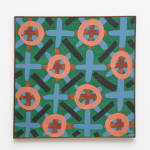
 'Foreigners Everywhere', 60th International Art Exhibition, Venice, Italy, 2024
'Foreigners Everywhere', 60th International Art Exhibition, Venice, Italy, 2024
 'Foreigners Everywhere', 60th International Art Exhibition, Venice, Italy, 2024
'Foreigners Everywhere', 60th International Art Exhibition, Venice, Italy, 2024
 'Foreigners Everywhere', 60th International Art Exhibition, Venice, Italy, 2024
'Foreigners Everywhere', 60th International Art Exhibition, Venice, Italy, 2024
Waldemar Cordeiro Brazilian, 1925-1973
29 1/2 x 29 3/8 inches
Further images
“The precision of art is not a craftsperson’s precision, but one of meaning. One can construct with rigor without rigid outlines. Form is not outline or envelope, but relation.”
—Waldemar Cordeiro, 1960
Situated chronologically between the phases of Concrete Art and Popcreto, between 1960 and 1963, Waldemar Cordeiro’s so-called Intuitive Geometry phase marks a significant moment in his oeuvre. These paintings retained the spatial organization of the canvas but set aside the ruler and compass in favor of more intuitive drawing and combinations of primary colors to achieve other tonalities. These variations reflect the climate and luminosity of the tropics – pinks, greens, oranges, purples, and yellows – blended in oil paint through lines inspired by the morphology of Brazilian plants. At the time, Cordeiro was studying native flora from the Serra do Mar. In his Concrete and Intuitive Geometry investigations he combined colors in spatially structured compositions designed to speak directly to the viewer’s innate perception.
Provenance
Waldemar Cordeiro Estate
Exhibitions
São Paulo, Brazil, Galeria Astreia, Waldemar Cordeiro, February 1963São Paulo, Brazil, Museum of Contemporary Art of University (MAC/USP), Waldemar Cordeiro Ume Aventura da Razão, 1986
São Paulo, Brazil, Itaú Cultural, Fantasia Exata, 3 July -22 Sept 2013
Rio de Janeiro, Brazil, Paço Imperial, 2014
São Paulo, Brazil, Geometria Intuitiva, Luciana Brito Galeria, 2022
Venice, Italy, Venice Biennale: Foreigners Everywhere, 20 Apr - 24 Nov 2024
Literature
Venice Biennale, 2024 entry for Untitled 1963:
Waldemar Cordeiro migrated to Brazil in 1946 and soon became the leader of the Concrete Art movement in São Paulo (1952–1959). Although Waldemar Cordeiro is better known for the radicalism with which he advocated for geometric abstraction devoid of subjectivity (achieved with industrial paint to eliminate traces of handmade brushstrokes), one of the most interesting moments in his artistic trajectory is the period of transition to the next phase of his art, when he would begin to add three- dimensional objects onto his paintings. Untitled (1963) was created during this brief transition. Here, the plus sign (+) and the multiplication sign (x), as well as the circles, are hand- painted on a solid green background. In this composition, he is no longer interested in demonstrating his skills in applying mathematics to construct optical illusions but rather he simply enjoys the pleasure of painting. Still using mathematical symbols, he creates a freehand pattern, where he simultaneously marks his presence and depicts a decorative image, both approaches he would once have found inconceivable. This is the first time the work of Waldemar Cordeiro is presented at Biennale Arte.
—Regina Barros




